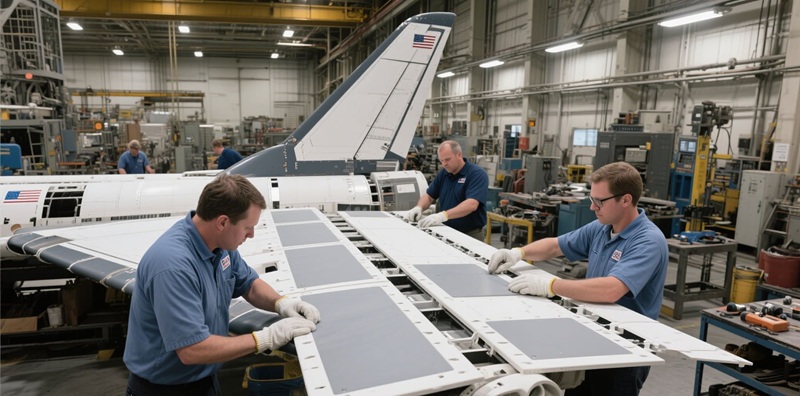How Do Aluminum Oxide Ceramics Enhance Aerospace Safety?
In the demanding world of aerospace, safety and reliability aren’t just priorities—they’re lifelines. Every component used in aircraft, satellites, and spacecraft must endure extreme conditions such as high-velocity impact, wide temperature fluctuations, and corrosive environments. While metals and composites play important roles, aluminum oxide ceramics—commonly known as alumina—have emerged as a critical material for mission-critical applications. But what makes these ceramics so valuable in aerospace safety systems? From thermal protection during re-entry to high-precision electronic insulation in avionics, this article delves into how alumina ceramics help ensure the structural integrity, performance reliability, and operational safety of aerospace systems.
At Advanced Ceramic Hub, we specialize in high-quality alumina ceramic, ensuring optimal performance for industrial and scientific applications.

What Are Aluminum Oxide Ceramics and Why Are They Used in Aerospace?
Aluminum oxide ceramics, commonly known as alumina, are advanced ceramic materials known for their exceptional hardness, thermal stability, corrosion resistance, and electrical insulation. These characteristics make them suitable for harsh aerospace environments where metal or polymer components might fail. Alumina maintains its performance even under intense heat, vacuum conditions, and high radiation, typical in aerospace operations.
Mechanical Properties
| Material | Unit | 95% Al2O3 | 96% Al2O3 | 99% Al2O3 | 99.5% Al2O3 | 99.7% Al2O3 | 99.95% Al2O3 |
| Density | g/cm3 | 3.7 | 3.7 | 3.85 | 3.9 | 3.95 | 3.98 |
| Bending Strength (20℃) | Mpa | 300 | 300 | 330 | 360 | 380 | 500-600 |
| Compressive Strength (20℃) | Mpa | 2000 | 2000 | 2000 | 2350 | 2000 | 3500 |
| Young’s Modulus (20℃) | Gpa | 270 | 275 | 370 | 370 | 380 | 400 |
| Fracture Toughness (20℃) | MPam½ | 3.5 | 3.5 | 4 | 4 | 4 | 4.5 |
| Poisson’s Ratio(20℃) | \ | 0.2 | 0.22 | 0.22 | — | 0.23 | 0.23 |
| Mohs Hardness(20℃) | HRA | 8.0-8.5 | 8.0-8.5 | 8.5-9.0 | 9.0 | 9.0-9.5 | 9.0-9.5 |
| Vickers Hardness (HV1) | kg/mm2 | 1600 | 1600 | 1600 | 1650 | 1750 | 1800 |
Thermal Properties
| Material | Unit | 95% Al2O3 | 96% Al2O3 | 99% Al2O3 | 99.5% Al2O3 | 99.7% Al2O3 | 99.95% Al2O3 |
| Thermal Expansion Coefficient (25-300 ℃) | 10-6K-1 | 6.5 | 6.5 | 7.6 | 7.2 | 7.2 | 7.5 |
| Thermal Conductivity (20℃) | W/mk | 20 | 25 | 27.5 | 32 | 32 | 45 |
| Thermal Shock Resistance | △T·℃ | 200 | 200 | 200 | 250 | — | 400 |
| Specific Heat Capacity | J/g·k | — | — | 0.79 | 0.78 | 0.79 | 0.80 |
| Max Operating Temperature (Oxygen Condition) | ℃ | 1600 | 1600 | 1650 | 1650 | 1700 | 1750 |
Electrical Properties
| Material | Unit | 95% Al2O3 | 96% Al2O3 | 99% Al2O3 | 99.5% Al2O3 | 99.7% Al2O3 | 99.95% Al2O3 |
| Volume Resistivity (20℃) | Ω·cm | 1014 | 1014 | 1014 | 1014 | 1014 | 1014 |
| Dielectric Strength | KV/mm | 10 | 10 | 10 | 15 | 15 | 16 |
| Dielectric Constant (1 MHz, 25℃) | \ | 9 | 9 | 9.1 | 9.9 | 9.9 | 9.9 |
| Dielectric Loss Tangent (1MHz, 20℃) | tanδ | 3*10-4 | 2*10-4 | 3*10-4 | 1*10-4 | 1*10-4 | 1*10-4 |
Explore our high-quality alumina ceramics.
In What Aerospace Fields Are Aluminum Oxide Ceramics Commonly Used?
Aluminum oxide ceramics find widespread application across a range of aerospace systems due to their ability to perform under extreme physical and thermal stresses. Their integration helps reduce weight, boost efficiency, and most importantly, improve the operational safety and durability of aerospace components.
- Thermal Protection Systems (TPS): Alumina ceramics are used to shield spacecraft from intense heat during atmospheric re-entry.
- Propulsion Systems: Components such as nozzle liners, valves, and injector plates use alumina for its resistance to erosion and thermal shock.
- Electronic and Sensor Insulation: High-purity alumina serves as a substrate for sensors, transducers, and microelectronic circuits.
- Structural Components: Reinforced alumina composites are used in lightweight, high-strength structures subjected to abrasion or impact.
How Do Aluminum Oxide Ceramics Improve Reliability and Safety in Extreme Conditions?
Alumina ceramics excel under conditions that would cause other materials to deform, crack, or melt. Their low thermal conductivity helps manage heat flow, while their mechanical rigidity resists deformation under pressure. Alumina’s ability to maintain performance over repeated thermal cycles adds to the long-term reliability and safety of aerospace systems. In rocket engines, for instance, alumina components show less wear and stress damage compared to traditional metal parts.
How to Choose the Right Grade of Aluminum Oxide Ceramic for Aerospace Safety?
Alumina ceramics come in various purity levels:
| Grade (Purity) | Typical Applications | Key Properties |
| 95% | Wear-resistant structural parts | Good strength, lower cost |
| 96% | Electrical insulators | Balanced dielectric & strength |
| 99% | Sensor substrates | High thermal & chemical stability |
| 99.5%+ | RF electronics, vacuum tubes | Excellent insulation properties |
| 99.99% | High-end aerospace electronics | Ultra-high purity, low defects |
Selecting the right grade depends on the specific requirements: electrical insulation, thermal conductivity, mechanical load, or resistance to plasma environments.
Request a custom quote for high-quality alumina ceramics.
How Do Aluminum Oxide Ceramics Compare with Other Aerospace Ceramics?
Choosing the best ceramic material for aerospace applications depends on a variety of performance criteria, including thermal resistance, mechanical strength, and electrical insulation. The table below compares alumina with other commonly used aerospace ceramics:
| Property | Alumina | Silicon Nitride | Silicon Carbide | Zirconia |
| Hardness | High | Moderate | Very High | Moderate |
| Thermal Shock Resistance | Moderate | Excellent | Excellent | Poor |
| Electrical Insulation | Excellent | Moderate | Poor | Good |
| Max Operating Temp | ~1600°C | ~1300°C | ~1400°C | ~1100°C |
Alumina offers a great balance of thermal, mechanical, and electrical properties, making it a go-to material in multi-functional aerospace components.
Can Aluminum Oxide Ceramics Help Reduce Maintenance and Improve Lifecycle Costs?
Yes. Alumina ceramics significantly extend the service life of aerospace components by resisting wear, oxidation, and mechanical fatigue. This reduces downtime, minimizes replacement frequency, and cuts overall maintenance costs. Their high reliability reduces the risk of in-flight failures, contributing to both economic and mission safety.
What Are the Key Safety Standards Related to Ceramic Materials in Aerospace?
Aerospace-grade ceramics often conform to:
- ASTM F1160: Test methods for flexural strength of advanced ceramics
- MIL-STD-1942: Thermal insulation materials for aerospace applications
- NASA-STD-6016: Standard materials and processes requirements for spacecraft
Alumina ceramics that meet these standards ensure compatibility with aerospace system requirements.
What Are the Future Trends of Aluminum Oxide Ceramics in Aerospace Design?
- Ceramic-metal composites are gaining attention for combining toughness with high-temperature resistance.
- 3D-printed alumina parts are enabling complex geometries and on-demand production.
- Nanostructured alumina may offer better fracture resistance and weight savings in the future.
These trends indicate the continued integration of alumina ceramics in next-generation aerospace platforms.
FAQ
| Question | Answer |
| Which grade of alumina is best for aerospace insulation? | 99.5% and above are preferred for high-frequency insulation. |
| Are alumina ceramics suitable for reusable spacecraft? | Yes, due to their thermal and mechanical stability. |
| Can alumina replace metal parts? | In many thermal and wear components, yes. |
| Do coatings improve ceramic safety in aerospace? | Coatings like alumina-TiC can further enhance surface wear resistance. |
| How thick should alumina parts be? | Depends on load, but usually 0.5–5 mm in structural or insulative roles. |
Conclusion
Aluminum oxide ceramics offer the unique combination of thermal, mechanical, and electrical performance that aerospace engineers demand. Their adaptability across propulsion, structural, and electronic systems makes them a critical material for safety-driven design. As technology advances, the role of alumina ceramics in building safer, more efficient aerospace systems will only expand.
Advanced Ceramic Hub provides high-quality aluminum oxide ceramics with customizable specifications to meet the demanding requirements of aerospace applications.
Looking for high-quality alumina ceramics? Contact us today!
